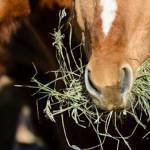Biofuel Boost from Fungal Enzymes in Horse Manure

In a presentation given at a recent National Meeting and Exposition of the American Chemical Society, researchers explained that horse manure may hold an important key to increasing production of biofuels.
Scientists from the University of California, Santa Barbara, have worked with researchers at the Broad Institute of the Massachusetts Institute of Technology and Harvard University to identify genetic material associated with a fungus isolated from equine manure. The fungus has the ability to produce hundreds of enzymes and other proteins that can break down lignin and cellulose in plant tissues.
Cellulose is the raw material from which biofuels are made. Using corn stalks, grass, and plant parts left after food and feed ingredients are harvested, the process starts by removing the tough lignin network through an industrial pretreatment process that is expensive and time-consuming. The same process takes place in the equine gut, engineered by fungi that break down lignin and turn cellulose into sugars. In the making of biofuel, these sugars feed the fermentation process that produces alcohol for fuel.
The natural fermentation process in animal guts has been explored previously by biofuel scientists, but the focus has been more on bacterial enzymes rather than fungi. The recently discovered fungus from horse manure has the potential to significantly reduce the cost of biofuel manufacturing. The goal of ongoing research is to isolate the genes that produce the lignin-reducing enzymes and splice them into yeasts that are already in use in the production of antibiotics, food, and other substances. Because the technology of utilizing yeast is already perfected, this process could be used more easily for commercial production rather than designing a process to use the fungi directly.
Intestinal fungi have not been studied as intensively as yeast, partly because yeast occurs in large quantities while levels of gut fungi tend to be much lower. Fungi are also more difficult to isolate, grow, and study in detail. The research team is continuing to analyze the enzymes produced by the fungi in an effort to identify those that are most active in breaking down lignin. The scientists will also work on ways to transfer genes into the yeast species that are currently used in biofuel production.








